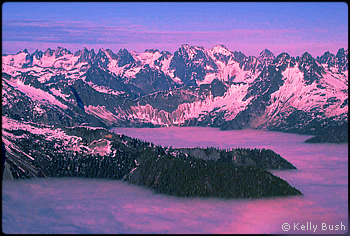| Mission | Submission Guidelines | Editorial Team |
| Issue 2 | Archive |


| North Cascades National Park, 2004 | ||
| by Kelly Bush, Wilderness District Ranger |
|
|
|||||||||
 |
||||||||||
 |
||||||||||
|
||||||||||
Staffing & Training A staff of ten rangers patrolled 24 cross-country zones in 2004 at least once. Patrols focused on standard high-use areas such as Boston Basin, Eldorado Basin, Inspiration Glacier, Triumph Col, and Mount Shuksan zones, but also made exploratory or resource focused trips to Bacon, Icy, Prophet, Teebone Ridge, Goode, and Spickard zones. Continuing on a largely roving schedule (only Cascade Pass and Copper Ridge had dedicated patrols), climbing patrols were optimized by often pairing one of three climbing rangers with Wilderness Information Center staff, Skagit and Bellingham Mountain Rescue, and other volunteers. One ranger was sent to the 40-hr Technical Rescue training at Canyonlands National Park. One climbing ranger was sent to the 40-hour Helicopter Crewmember S271 training. SAR 101 training (8 hrs) was provided for new staff and conducted by NOCA climbing rangers. The SAR team participated in two days training at the Newhalem cliffs with Conterra Systems and two days training on technical raises and lowers at Gorge Creek cliffs, with a rescue scenario off Thunder Knob. In addition to this Search and Rescue training, the Wilderness District Ranger became a member of the Interagency Short-haul Working Group and attended the annual meeting in January, 2005. North Cascades National Park intends to establish an approved DOI short-haul program and is planning the first steps in its implementation in the 2005 season. In June 2005, SAR team staff will hold bi-annual helicopter step-out landing training and certification; if the above are accomplished it is the hope to also start with short-haul training and proficiency testing with pilots and rangers. Climbing Visitation Number of parties in selected cross-country areas, from backcountry permit data:
2004 Projects in Cross-country/Climbing Areas Glacier Study Climbing rangers participated with park geologists on a glacier mass balance study, assisting on the Silver, North Klawatti, Noisy, and Sandalee Glaciers.
A memorial site with large signs and other development at Vulcan Lake (which is along the approach route to the Banded Glacier on Mount Logan) was reported by a climbing party. The subsequent investigation located the family members, who had hired a helicopter to transport them and the memorial materials to the site. Two rangers cleaned the site and carried out everything in multiple trips in September, 2004. A push was resumed to clean excess climbing webbing from anchor points on one or two routes per season (these were Sharkfin Tower and Mt Triumph in 2004) and encourage a visitor effort for this in future seasons. Waste Management Light snowpack and good luck resulted in another year of 100% winter survival of the park’s composting toilets. None required replacement and rangers maintained 16 composting toilets (as well as lower elevation pit toilets) in subalpine or alpine sites. Rangers documented 43 instances of improper waste disposal in patrol reports (feces on snow primarily in Eldorado and Sulphide Glacier zones, down from 89 in 2003) and the Wilderness Information Center (and other permit issuing centers) gave out approximately 600 blue bags. Search and Rescue North Cascades National Park personnel responded to 17 incidents in 2004, of which 9 were major SAR incidents. The total unprogrammed emergency cost to the National Park Service was $20,978, of which $11,685 was for helicopter flight time. Some of the 17 incidents of 2004 are summarized in the sidebar. |
|
|||||||||||||||||||||||||||||||||||||||||||||||||||||||||||||||||||||||||||||
| ©2005 Northwest Mountaineering Journal | ||||||||||||||||||||||||||||||||||||||||||||||||||||||||||||||||||||||||||||||
| Site design by Steve Firebaugh |